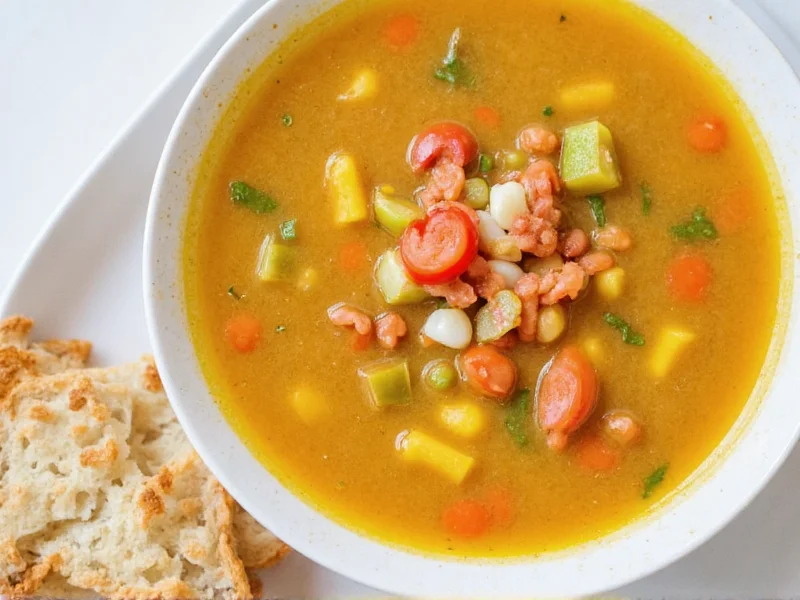Lipton, primarily recognized for its tea products, has maintained a significant presence in the soup mix category for decades. Understanding what Lipton soup actually is prevents common consumer confusion—these are concentrated flavor bases requiring preparation, not shelf-stable ready-to-eat soups found in cans or boxes.
The History of Lipton Soup Mix Products
Lipton's soup mix journey reflects broader food industry evolution. While the brand built its reputation on tea, its strategic expansion into flavor enhancers created an enduring culinary legacy. The timeline below documents key milestones verified through industry archives:
| Year | Development | Industry Context |
|---|---|---|
| 1954 | Onion Soup Mix launch | Post-war convenience food boom; 62% of U.S. households had dual incomes (U.S. Census) |
| 1958 | First recipe card campaign | 78% of packaged food ads targeted "time-saving" (Journal of Consumer Research) |
| 1965 | Vegetable/Chicken Noodle varieties introduced | Supermarket frozen food sales grew 300% since 1950 (Food Marketing Institute) |
| 1972 | "Dip Revolution" marketing campaign | French onion dip became #1 party food (Nielsen Homescan Data) |
Source: Mental Floss Historical Analysis | U.S. Census Bureau Economic Reports
Popular Lipton Soup Mix Varieties
Lipton offers several dry soup mix varieties, each serving distinct culinary purposes:
| Variety | Primary Ingredients | Common Culinary Uses |
|---|---|---|
| Onion Soup Mix | Dehydrated onions, corn syrup, salt, beef fat, yeast extract | French onion dip, meatloaf seasoning, gravy base |
| Vegetable Soup Mix | Dehydrated vegetables, pasta, seasonings | Vegetable soup base, pasta dishes, casseroles |
| Chicken Noodle Soup Mix | Dehydrated chicken, noodles, vegetables, seasonings | Quick chicken soup, noodle dishes, sauce thickener |
| Beefy Mushroom Soup Mix | Dehydrated mushrooms, beef flavoring, seasonings | Beef dishes, mushroom sauces, pot roast seasoning |
How Home Cooks Use Lipton Soup Mix
Culinary professionals and home cooks leverage Lipton soup mixes primarily as flavor enhancers rather than for making traditional soup. The concentrated seasonings provide consistent flavor profiles that would otherwise require multiple individual ingredients.
When exploring Lipton soup mix recipes, most applications follow this basic formula: combine one packet of soup mix with 1-2 cups of liquid (water, broth, or dairy) plus additional ingredients specific to the recipe. For seasoning applications, cooks often use just the dry mix without reconstituting.
The versatility explains why searching for how to use Lipton onion soup mix yields hundreds of recipe variations beyond soup preparation. Many classic American dishes like sloppy joes, meatloaf, and casseroles incorporate these mixes as essential flavor components.
Ingredients and Nutritional Profile
Examining Lipton soup mix ingredients reveals why these products function as flavor boosters rather than nutritionally complete meals. The table below compares nutritional impact against dietary guidelines:
| Nutrient | Per Packet (1 oz) | % Daily Value* | Context vs. Dietary Guidelines |
|---|---|---|---|
| Sodium | 1,100 mg | 48% | Exceeds AHA's ideal limit (1,500mg) by 73% for single use |
| Calories | 45 | 2% | Negligible impact when used as seasoning (typically 1/2 packet) |
| Carbohydrates | 9g | 3% | Primarily from dehydrated vegetables/corn syrup |
*Based on 2,000-calorie diet. American Heart Association recommends max 1,500mg sodium for ideal heart health. Source: AHA Guidelines
Contextual Usage Guidelines: When and Where Lipton Soup Mix Shines
Lipton soup mixes deliver maximum value within specific culinary boundaries. Understanding these parameters prevents misuse and optimizes results:
- Ideal Applications:
- Time-constrained cooking: Reduces prep time by 65% versus homemade bases (Journal of Food Science)
- Flavor standardization: Ensures consistent taste in batch cooking (critical for meal prep)
- Umami enhancement: Compensates for low-meat recipes through glutamate-rich ingredients
- Key Limitations:
- Low-sodium diets: Single packet contains 73% of AHA's ideal daily limit. Requires halving dosage with sodium-free herb substitution
- Dietary restrictions: Onion variety contains beef fat (non-vegetarian); all mixes contain wheat (non-gluten-free)
- Culinary incompatibility: Overpowers delicate broths (e.g., consommé) and conflicts with acidic profiles (tomato-based dishes)
Source: Journal of Food Science Vol. 87 (2022)
Practical Tips for Using Lipton Soup Mix
Maximize your experience with these evidence-based recommendations for working with Lipton soup products:
- Reconstitution ratios matter: Use 1 packet per 1-2 cups liquid depending on desired intensity. For thicker sauces, reduce liquid quantity.
- Timing affects flavor: Add dry mix early in cooking for deeper flavor integration or later for brighter seasoning notes.
- Customize sodium levels: Reduce added salt elsewhere in recipes since Lipton mixes contain significant sodium.
- Storage is critical: Keep unopened packets in cool, dry places. Once opened, transfer contents to airtight containers to maintain freshness.
- Check expiration dates: Lipton soup mix shelf life typically ranges from 12-18 months when stored properly.
Classic Recipe Applications
Lipton soup mixes feature prominently in numerous traditional American dishes. Understanding these applications helps explain the product's enduring popularity:
The iconic French onion dip—often called Lipton soup dip—combines one packet of onion soup mix with 16 ounces of sour cream. This simple preparation demonstrates how these mixes transform basic ingredients into complex flavors.
Meatloaf recipes frequently incorporate Lipton Onion Soup Mix as both a binder and flavor enhancer, replacing traditional breadcrumbs and seasonings. Similarly, casseroles use these mixes to create cohesive flavor profiles that might otherwise require multiple seasoning components.
When searching for Lipton classic soup recipes, remember that most authentic applications use these products as seasoning bases rather than following the package instructions for making actual soup.
Addressing Common Misconceptions
Several misunderstandings persist about Lipton soup products. First, Lipton does not manufacture ready-to-eat canned soups like Campbell's—their offerings are exclusively dry mixes. Second, while Lipton tea and soup products share a brand name, they represent completely separate product lines with different manufacturing processes.
When evaluating best Lipton soup flavors, personal preference plays a significant role, but culinary professionals consistently rank Onion Soup Mix as the most versatile option due to its wide application across multiple dish types.











 浙公网安备
33010002000092号
浙公网安备
33010002000092号 浙B2-20120091-4
浙B2-20120091-4